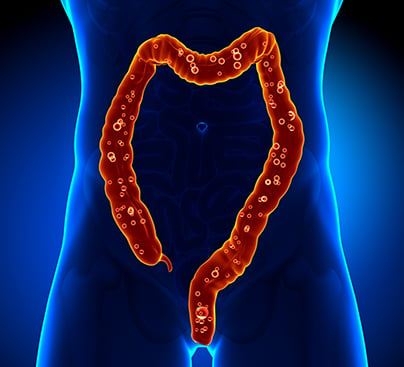Recipes
Diverticulosis is a condition in which small bulging sacs or herniations of the intestinal wall abnormally develop in the large intestine. Diverticulitis, a separate condition, is the inflammation of these diverticula, typically caused by infection.

Diverticulosis is very common in developed nations. Westernized countries have the highest incidence of lifestyle-related diverticulosis. It is estimated that approximately 27% or more of the Westernized population has diverticulosis,1 with roughly 15% of them experiencing symptoms (such as diverticulitis). So, most people who have diverticula will not even feel any symptoms. If symptoms do develop, however, they may include:
It is unclear why some people with diverticulosis develop inflammation or infection of the diverticula, which is then considered diverticulitis. Diverticulitis often causes extreme pain in the lower left area of the abdomen, as well as fever, nausea, and constipation or diarrhea. With diverticulitis, complications can develop such as bleeding, intestinal blockages or burst of a diverticulum leading to leakage of intestinal contents into the abdominal cavity.
So, how does one prevent getting diverticulosis? The answer is actually quite simple: fiber. Eating natural fiber from whole plant foods performs essential functions in our bodies; one of these functions is to protect the intestines from getting these herniations. Soluble and non-soluble fiber both have been shown to play a role. This means that, while getting in a variety of whole fruits, vegetables, nuts, seeds, and legumes in your diet every day, you are directly lowering your risk of diverticulosis without having to think about it. The foods that are low in fiber and linked to a higher risk of developing diverticular disease are processed foods and animal products, which are all low or void of fiber. A Nutritarian diet is very high in fiber, anti-inflammatory substances, and pre-biotic substances that fuel favorable bacterial growth, making it an ideal solution to this common problem. In fact, in my 25-year history as a family physician who performed flexible sigmoidoscopies on hundreds of patients every 5 years as a screening evaluation, I have observed diverticular disease improve and even resolve in those committed long-term to a Nutritarian diet.
Staying physically active is a way to minimize the effects of constipation and keep you more regular and will complement efforts to increase fiber in your diet. Being regularly physically active will also help lower the risk of developing diverticulitis.
ONLINE: All members of DrFuhrman.com can search the Ask the Doctor archives for discussions on this topic. Platinum and Diamond members can connect with Dr. Fuhrman by posting questions in the forum. Not a member? Join now.
IN PERSON: Book a stay at Dr. Fuhrman’s Eat to Live Retreat in Southern California. With options ranging from one, two and three months (and sometimes longer) you will be under Dr. Fuhrman’s direct medical supervision as you hit the “reset” button on your health. For more information: (949) 432-6295 or info@ETLRetreat.com.
EVENTS: Join Dr. Fuhrman for an online boot camp, detox or other event. During these immersive online events, you’ll attend zoom lectures, follow a special meal plan, and have access to a special, live Q&A session with Dr. Fuhrman. Learn more about events.
The following are sample questions from the Ask the Doctor Community Platinum and higher members can post their health questions directly to Dr. Fuhrman. (All members can browse questions and answers.)
I was recently diagnosed with diverticulitis. I was put on two antibiotics and told to eat a low-residue diet. This diet is very low in fiber. I feel much better and am looking to make a lifestyle change for the better to avoid this happening again. Do you have any suggestions?
I do not agree with the concept of a low-residue diet, as I do not think it will help you. You should be eating a Nutritarian diet. Avoiding fiber, seeds, nuts, and other natural foods is NOT helpful. That myth was already disproved. When a study actually investigated this myth, it found they help, not hurt.
Ease in by eating more brown and wild rice and more butternut and acorn squash than I usually recommend, and then, in a few weeks, gradually reduce some of these cooked carb foods and eat more salad, vegetables, and more raw carbs. Lastly, many people have reversed their diverticulosis on a Nutritarian diet, and on repeat flex sigmoidoscopies I have performed on patients, I have seen them resolve after 5 years of strict adherence.
I have a history of multiple diverticulitis attacks and history of irritable bowel type symptoms. I am concerned about the amount of fiber I will take in on this diet. Any feedback on what I should do to minimize any future attacks of either condition?
Fiber will be an important part of healing from your gut issues. Chew all of your food well and eat slowly. Start with half a cup of beans at lunch and dinner, along with steamed and raw greens and other vegetables. See how you feel. I think your gut symptoms will improve on this diet regimen, but if you are not tolerating all the fiber at first, cut the beans to just two tablespoons and eat more oatmeal, brown rice, potato, and squash and fewer raw vegetables. Gradually incorporate more raw and less cooked vegetables, with a gradual increase in the amount of beans as well.